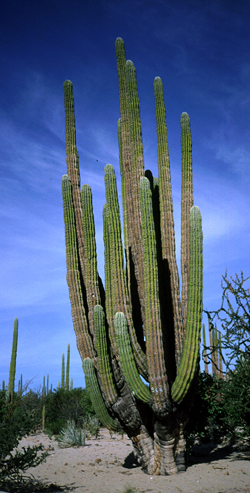August
2002
Did you know that
the Cardón cactus (Pachycereus pringlei)
have been measured as the
largest cactus in the world?
 |
|
Cardon (Pachycereus
pringlei)
|
Cardon (Pachycereus
pringlei)
The
cardón cactus (Pachycereus pringlei) is the world’s
largest cactus. There are about 1200 species of cactus, all of them
native to the Americas. Théò
giant cactus dominates many of the deserts of Baja California peninsula
and the coastal region of the state of Sonora in
Mexico.
Some of the largest cardones
have been measured at nearly 21 meters (70 feet) high and weigh up to
25 tons. These very slow growing plants are also extremely long-lived,
and many specimens live well over 300 years. “Cardo” means
“thistle” in Spanish. It is said that when Hernando Cortés
attempted to establish a settlement in Baja in 1535, the many spiny
cacti earned it the name “Isla de Cardón”, because
at the time, they believed the peninsula was an island.
The Sonora Desert in Baja can be
divided into distinct sub-regions. The cardón has adapted to
all of these sub-regions. In many of these areas, the cardón is the
predominant plant, and may be found growing in large tracts of forest.
Mature cardons can either be found in mixed
communities with other large plants such as boojum trees, or can form
cardon "forests" that dominate the landscape.These large stands of the tall columnar cacti are called “cardonales”.
The trunk and main
branches of cardon have from 11 to 17 vertical ribs. On young plants
the spines can be very conspicuous, but they are lost with age and are
not replaced. The lower parts of
older plants develop a "corky", cracked, woody base as the
outer succulent tissues begin to decay. Eventually, the plants die and
their internal woody "skeleton" is then evident - a complete
cylinder of woody tissue at the base, and vertical woody ribs running
up the length of the stem.
Woody vertical ribs allow the columnar cactus to expand
and contract like an accordion, storing the water it needs to survive
in the arid conditions. These cacti have developed extensive, shallow
root systems which quickly capture the brief, but torrential rains of
the region. A large cardón may store over a ton of water in the
fleshy, pulp-like tissues of its trunk. In order to support this great
weight, the large cactus has an interior framework of hardwood
vertical rods, lightweight, yet extremely strong, which act to stiffen
the ribs. This amazingly tough hardwood skeleton has allowed the cardón
to become the largest cactus species, able to thrive in the very harsh
climate of the Sonora desert of Baja California.
From March through June, cardons
produce a large number of flower buds on the ribs at the tips of the
older branches. The buds give rise to a succession of large blooms,
each of which remains open for only about 24 hours, but the period of
flowering can last for 3-4 weeks because the buds mature at different
times.Flowers open in the
afternoon, stay open all night, then close about mid-morning the next
day. The reason for this, is that the cardón,
like most of the other columnar cacti of the southwestern corner of
North America, depends on nightly visits from nectar feeding bats for
pollination. The flowers are visited by bats at night and by bees during
daytime.
Source:
http://helios.bto.ed.ac.uk/bto/desertecology/cardon.htm
http://www.loscabosrestaurantguide.com/cardon%20cactus.htm
|
